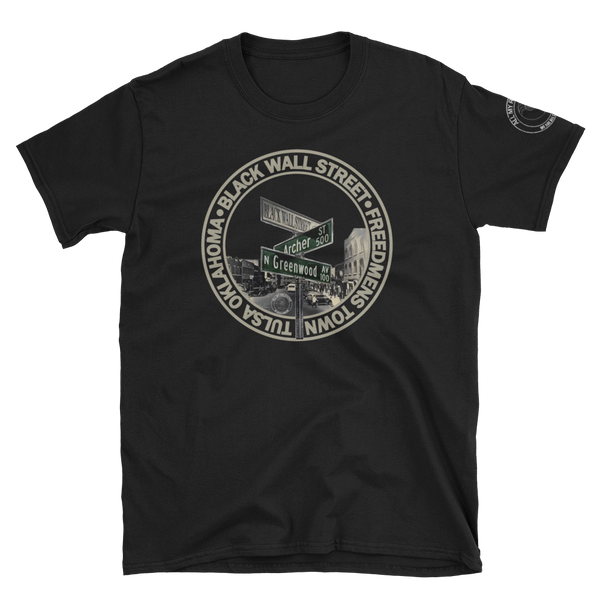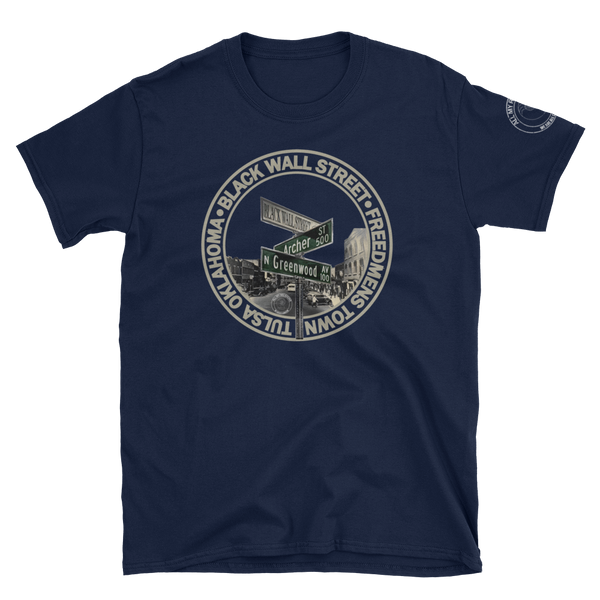

BlackWallStreet
Regular price
$25.00
Black Wall Street
From 1889 – 1907 African Americans began moving west and gathering in Oklahoma in hopes to take part in the land grab and start a new life. They wanted a life away from slavery, segregation, racial oppression and Jim Crow laws. Some of them were trying to regain the land of their ancestors. Many of them were related to the members of the five civilized tribes (Cherokee, Choctaw, Muscogee (Creek), Chickasaw and Seminole). Others who were not directly related had ties to the area; they had been adopted by the tribes after the Emancipation Proclamation. As Tulsa OK, began to grow, African Americans thrived there creating their own business district called Greenwood (Black Wall Street). Greenwood was a street that ran through the community with exclusive black owned businesses on it. They had everything including grocery stores, libraries, schools, churches and banks. In 1906 this area of Tulsa Ok, became known as Greenwood. In 1910 due to the oil boom Tulsa Ok, flourished and Greenwood benefitted from it. Due to the success of Greenwood, prominent black businessmen like O.W. Gurley and physicians like Dr A.C. Jackson moved into the area. Up until June 1st 1921, Greenwood (Black Wall Street) was a dream come true for African Americans looking for a place to call home in the United States. Until tragedy struck, sometime in the night between May 31st and June 1st of 1921- one of the biggest race riots in American History began. It all started because of an alleged attack in an elevator on a 17-year-old white female named Sarah Page by a 19-year old African American male named Dick Rowland. Greenwood (Black Wall Street) was burned to the ground. Thousands of white residents from the prominent white community crossed over into Greenwood and destroyed over 1200 homes and businesses. It left an unknown amount of people dead (estimated over 300) and 9000 people left homeless. The town was ransacked, looted and fire bombed by air planes. Machine guns were mounted on pick trucks and used to decimate the town. In the morning the area was unrecognizable. The residents of Greenwood either fled, were arrested or killed. Sadly, just before the violence started the charges against Dick Rowland were dropped and Sarah Page gave the police a statement recanting the allegations of assault……………….There is not enough space here to give this story the justice it deserves. We only hope this will inspire you to do some of your own research. It is also devastating to see the effects of unjustified and illegitimate hatred solely based upon skin color and cultural divide. May we never see things like this happen again.
You've now found the staple t-shirt of your wardrobe. It's made of a thicker, heavier cotton, but it's still soft and comfy. And the double stitching on the neckline and sleeves add more durability to what is sure to be a favorite!
• 100% ringspun cotton
• 4.5 oz/y² (153 g/m²)
• Pre-shrunk
• Shoulder-to-shoulder taping
• Quarter-turned to avoid crease down the center
From 1889 – 1907 African Americans began moving west and gathering in Oklahoma in hopes to take part in the land grab and start a new life. They wanted a life away from slavery, segregation, racial oppression and Jim Crow laws. Some of them were trying to regain the land of their ancestors. Many of them were related to the members of the five civilized tribes (Cherokee, Choctaw, Muscogee (Creek), Chickasaw and Seminole). Others who were not directly related had ties to the area; they had been adopted by the tribes after the Emancipation Proclamation. As Tulsa OK, began to grow, African Americans thrived there creating their own business district called Greenwood (Black Wall Street). Greenwood was a street that ran through the community with exclusive black owned businesses on it. They had everything including grocery stores, libraries, schools, churches and banks. In 1906 this area of Tulsa Ok, became known as Greenwood. In 1910 due to the oil boom Tulsa Ok, flourished and Greenwood benefitted from it. Due to the success of Greenwood, prominent black businessmen like O.W. Gurley and physicians like Dr A.C. Jackson moved into the area. Up until June 1st 1921, Greenwood (Black Wall Street) was a dream come true for African Americans looking for a place to call home in the United States. Until tragedy struck, sometime in the night between May 31st and June 1st of 1921- one of the biggest race riots in American History began. It all started because of an alleged attack in an elevator on a 17-year-old white female named Sarah Page by a 19-year old African American male named Dick Rowland. Greenwood (Black Wall Street) was burned to the ground. Thousands of white residents from the prominent white community crossed over into Greenwood and destroyed over 1200 homes and businesses. It left an unknown amount of people dead (estimated over 300) and 9000 people left homeless. The town was ransacked, looted and fire bombed by air planes. Machine guns were mounted on pick trucks and used to decimate the town. In the morning the area was unrecognizable. The residents of Greenwood either fled, were arrested or killed. Sadly, just before the violence started the charges against Dick Rowland were dropped and Sarah Page gave the police a statement recanting the allegations of assault……………….There is not enough space here to give this story the justice it deserves. We only hope this will inspire you to do some of your own research. It is also devastating to see the effects of unjustified and illegitimate hatred solely based upon skin color and cultural divide. May we never see things like this happen again.
You've now found the staple t-shirt of your wardrobe. It's made of a thicker, heavier cotton, but it's still soft and comfy. And the double stitching on the neckline and sleeves add more durability to what is sure to be a favorite!
• 100% ringspun cotton
• 4.5 oz/y² (153 g/m²)
• Pre-shrunk
• Shoulder-to-shoulder taping
• Quarter-turned to avoid crease down the center
Size guide
| S | M | L | XL | 2XL | 3XL | |
| Length (inches) | 28 | 29 ¼ | 30 ¼ | 31 ¼ | 32 ½ | 33 ½ |
| Width (inches) | 18 | 20 | 22 | 24 | 26 | 28 |